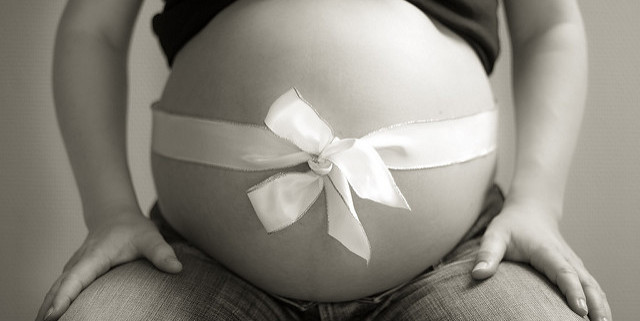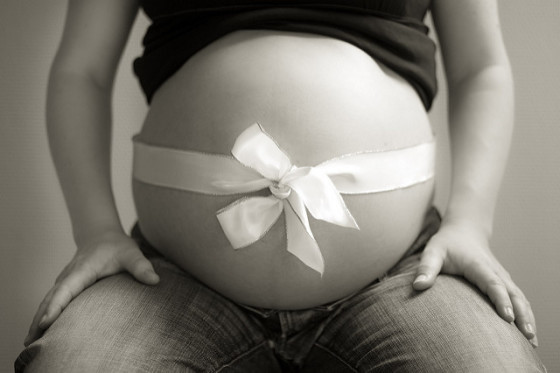First Signs of Labor: How to Know When Baby is Coming
Article at a Glance
- The first signs of labor are well before delivery. Within a month of your due date, you may feel baby change positions to get ready for birth or experience Braxton Hicks contractions. Your cervix also will dilate and you may pass your "bloody show."
- When labor actually starts, you'll feel more intense contractions and your water will break. Sometimes, Braxton Hicks contractions will continue as a false labor. True labor pains travel from the back to the front of your body, and the contractions are more painful.
- These signs of labor approaching may also appear if you're experiencing preterm labor. Seek medical attention immediately, particularly if you are at 36 weeks or less.
Last updated April 21, 2018.
When you first get pregnant and start your prenatal care, your doctor will give you a due date. For the next 40 weeks, people will ask you when you’re due. We tend to say it with a sense of confidence — “Oh, I’m due on October 9.” We might even plan for it, inviting relatives into town to meet the new baby. However, that’s no guarantee that you’ll actually go into labor on October 9. In part, that’s because the prediction of a due date is just a rough estimate since it’s difficult to pin down the exact time of conception. In part, it’s because 40 weeks is just an average gestation and some women are going to deliver a little earlier or a little later.
So if you can’t put “Start Labor” in your calendar, how do you know when it’s happening? What are the first signs of labor?
Contents
The First Signs of Labor Happen Way Before Delivery
We picture labor and delivery as something that starts suddenly and ends a few hours later with a baby. Actually, your body starts preparing for labor weeks in advance. As early as a month before you actually go into labor, you might feel a “lightening” of your belly as the baby flips around to get in position for birth. It may be easier to catch your breath, since that relieves some of the pressure on your ribcage.
Weeks before you go into proper labor, you may start to notice Braxton Hicks contractions. These are sort of practice contractions; they actually start within the first couple of months of your pregnancy but you won’t be able to feel them until you’re closer to your due date. Also, some women don’t experience Braxton Hicks contractions at all. If you do get them, Braxton Hicks contractions are typically irregular and not painful, although they may be uncomfortable. Real contractions will get steadily longer and closer together, while Braxton Hicks contractions will come in and out.
As you get close to your delivery day, your cervix will start to “ripen” in preparation. That means it will start to thin out and perhaps even dilate a bit. If it dilates enough, you may pass your mucus plug (also called your “bloody show”). That’s the lump of thick mucus that has blocked off your cervical passage through your pregnancy; it may come out all at once or in piece over several days. Sometimes it’s tinged with blood, hence the “bloody show” nickname.
Signs of Labor Approaching
So, your body will start to prepare for labor way before it actually happens. Of course, that’s not telling you anything new — you already have a rough idea of when you’ll deliver. So how do you know it’s the real deal?
Contractions
You may have been feeling Braxton Hicks contractions for a month or more, but you’ll know the difference when real labor contractions kick in. Braxton Hicks contractions aren’t necessarily pleasant, but they’re also generally not painful. Real contractions are much more intense. They’ll also get steadily stronger, longer, and more frequent.
Your Water Breaks
One of the most unmistakable first signs of labor is your water breaking. The amniotic sac that surrounds the baby will break in preparation for delivery and that fluid will flow out through your vagina. For some women it’s a small trickle, but for others it’s more of a flood. You’ll probably already be having contractions by the time your water breaks, or they’ll start soon afterward. In any event, you should contact your doctor or midwife to let them know your water has broken. If you don’t start true labor within 12-24 hours, they may need to induce your labor to reduce the risk of infection.
False Labor
With Braxton Hicks contractions and other changes to your body, how can you tell the difference between the first signs of labor and false labor? These are a few things to look for:
- Regularity: Braxton Hicks contractions may get strong and even painful and may occur every 10-20 minutes, but they won’t progress. True contractions will get closer together and more intense.
- Pain: True labor pains often travel from the back to the front of your body. False alarms are often concentrated at the front.
- Bloody show: If you pass your mucus plug, you’re probably approaching true labor.
See also: Epidurals for Delivery: Pros and Cons
Will my baby come early?
These signs will also appear if you’re entering labor preterm. If you think you may be going into labor early, it’s best to call your doctor or midwife immediately. This is especially crucial before 37 weeks; premature babies are at risk for a variety of health problems and there may be steps your medical care team can take to help delay your delivery.
If your water breaks, if you have pelvic pain, or if you notice unusual vaginal discharge, you should seek immediate medical attention. Pay attention to any vaginal discharge; your medical care providers will need to know if it’s bloody (which could indicate internal bleeding) or greenish or brownish (which could indicate meconium release due to fetal distress).
Signs Baby is Coming are Different for Everyone
At the end of the day, it’s always better to call your doctor or midwife if you’re unsure about whether you’re in labor. Every pregnancy is different and the first signs of labor will be different for everyone. Your doctor or midwife will be familiar with your unique pregnancy and will be be able to help guide you through false alarms and identify the real deal.
Image Credit and License









you did teach me things thank you
THANKS FOR UR CARE
thanks you so much
Thanks